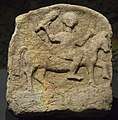Andriake
Andriake or Andriaca (Ancient Greek: Ἀνδριάκη) was an ancient city and the port of the ancient town of Myra in Lycia. Appian (B.C. iv. 82) says that Lentulus broke through the chain which crossed the entrance of the port, and went up the river to Myra. Beaufort (Karamania, p. 26) gives the name Andráki to the river of Myra. On the north side of the entrance are the remains of large Roman horrea, with a perfect inscription, which states that the horrea were Hadrian's: the date is Hadrian's third consulate, which is 119 CE.
Ἀνδριάκη | |
 Shown within Turkey | |
| Location | Demre, Antalya Province, Turkey |
|---|---|
| Region | Lycia |
| Coordinates | 36°14′50″N 29°58′58″E |
| Type | Ancient Settlement and port |
Andriake is mentioned by Ptolemy; and Pliny has Andriaca civitas, Myra (v. 27). Andriake, then, is clearly the place at the mouth of the small river on which Myra stood, 20 stadia higher up. (Strab. p. 666.) It must have been at Andriake, as Cramer observes, that St. Paul and his companions were put on board the ship of Alexandria. (Acts, xxvii. 5, 6.)
Andriake is located in what is now the Demre district of Antalya.
The location has re-opened [1] as an open-air museum with a museum in an old granary. A notice on site (see picture Andriake Plan with text below) has: "Although it was an important harbour of the Lycian region in (the) Ancient Period, in part (because) of the alluvial silt transported by Kokarçay (Andriakos), the port ceased functioning and the ruins of the city Andriake, today engulfed by a swamp, are spread over the two shores of a small bay. Far from being an independent city in (the) Ancient Period, the city Andriake was a suburb and (the) port of Myra by (sic) its location. The inscription located in the city that covers trading laws of the Lycian state from (the) Emperor Nero period (54-68) exposes the importance of Andriake as a port during this period. Andriake lived its most prestigious period during Emperor Hadrian (117-138). The granarium/grain silo structure (Lycian Civilizations Museum) and the trade agora/plakoma structure on its eastern side were built in this period. Discovery of inscriptions written in the honour of Constantinus II, Julianus and Valens indicated that Andriake succeeded in maintaining its importance also in later periods (4th century AD).
Gallery
 Andriake Church A 0233
Andriake Church A 0233 Andriake Church B 0249 panorama
Andriake Church B 0249 panorama Andriake Eastern Bath 0234
Andriake Eastern Bath 0234 Andriake Harbour agora 0266
Andriake Harbour agora 0266 Andriake Harbour agora cistern 0274 panorama
Andriake Harbour agora cistern 0274 panorama Andriake Harbour area 0287
Andriake Harbour area 0287 Andriake Harbour area Reconstructed ship 0298
Andriake Harbour area Reconstructed ship 0298 Andriake Harbour area Reconstructed ship 0307
Andriake Harbour area Reconstructed ship 0307 Andriake Harbour area Reconstructed ship 0305
Andriake Harbour area Reconstructed ship 0305 Andriake Harbour area Conferment monument 0296
Andriake Harbour area Conferment monument 0296 Andriake Plan with text
Andriake Plan with text Andriake Museum Votive stele 12 gods 0343
Andriake Museum Votive stele 12 gods 0343 Andriake Museum General view 0339
Andriake Museum General view 0339 Andriake Museum General view 0335
Andriake Museum General view 0335 Andriake Museum Votive stele Kakasbos 0348
Andriake Museum Votive stele Kakasbos 0348
External links

References
![]()